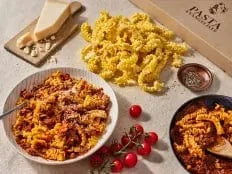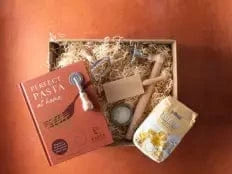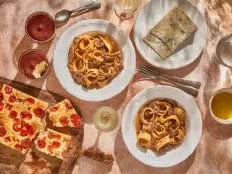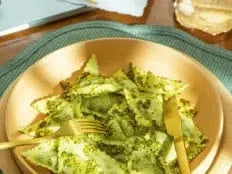An Italian staple of modern origins, this bread is characterised by its crisp crust and distinct, chewy centre. Although ciabatta can now be found all over Italy, it originally comes from the northern province of Rovigo, and is most closely recognised as a Venetian invention, created in 1982 in response to the popularity of French baguettes (ciabatta being akin to the old French chavate, or ‘old slipper’).
The dough itself is made from lean yeast, which means that there is no fat in the resulting bread, creating a beautiful crust that crinkles and cracks when torn in half. Like sourdough bread, ciabatta is also made using a pre-fermented dough called biga. Yeast, flour, and water are combined for hours before the dough is made, resulting in a porous texture. Ciabatta’s unique flavour is also due to the quantity of liquid used in making the dough; its high hydration ratio allows it to take on a lot of moisture, again helping to give the bread its supremely soft centre.
Although this bread’s preparation time is a little longer than your standard loaf, it is also relatively hands off; the perfect relaxing endeavour for a rainy day to accompany your next Italian feast.
Our Ciabatta Recipe
Makes: 3 oblong loaves
Nutrition per 100g: 339kcal
Prep time: overnight + 1 hour the following day
Cooking time: 15-20 minutes
Ingredients
Biga (pre-ferment made the day before)
- 250g strong white bread flour
- 190ml water
- 15g dried active yeast
The dough
- 250g strong white bread flour
- 10g dried active yeast
- 190ml water
- A pinch of salt
Method
- To make the biga, combine the flour and water in a large bowl before adding the yeast. Mix for 2-3 minutes until everything is well incorporated and leave to rise overnight in a cool room or the fridge. If you are unable to leave the biga to rise overnight, 8 hours should also be enough.
- The next morning, add the remaining flour and yeast to the biga and mix well. Slowly pour the rest of the water into the bread mixture. When nearly all the water has been added, add the salt to the remaining water and mix together for a further 5 minutes, until a sticky dough is formed. *Note that your dough should be quite wet. Resist the temptation to add more flour as this will make the dough thick and the bread won’t be as soft or porous when baked.
- Grease a large bowl with olive oil, transfer the dough and leave to rise for an hour (or until doubled in size).
- Transfer the dough to a floured work surface and leave to rest for a further 30 minutes. Preheat the oven to a hot 240c (210c fan).
- Cut the dough evenly into three strips and stretch them out to make the classic long ciabatta loaf shapes.
- Place each ciabatta onto a baking tray lined with greaseproof baking paper and leave to slightly rise for a further 10 minutes. Top with a little bit of flour for an artisanal finish.
- Put the dough into the oven to bake for 15–20 minutes, or until it rises and is a beautiful golden-brown colour. Remove from the oven and transfer to a wire rack to cool.
- Eat and enjoy. Buon appetito!
How to serve or use your ciabatta
Ciabatta is a versatile bread that can be enjoyed in many ways. Some of our favourite ways to use ciabatta include:
- Bruschetta: Top with grilled vegetables (traditionally tomatoes, but other vegetables like courgettes and aubergines also work well), garlic, olive oil, and fresh basil.
- Dipping Bread: Serve with olive oil and balsamic vinegar, or a selection of dips like pesto, tapenade, or hummus.
- Panini: Fill with your favourite salumi, cheese, and vegetables for a quick and satisfying lunch.
- Soup: Ciabatta is perfect for soaking up flavourful soups and stews like Ribollita.
Ciabatta also excels at soaking up flavourful sauces that accompany pasta dishes. Its porous structure allows it to absorb the sauce without falling apart. This works particularly well in dishes like Spaghetti alla Busara, where the garlic, herbs, and seafood create a rich and flavourful broth. Even simpler sauces like Puttanesca, with its abundance of tomatoes, olives, and capers, benefit from having a piece of ciabatta to soak up the delicious juices.
: invalid url input)







